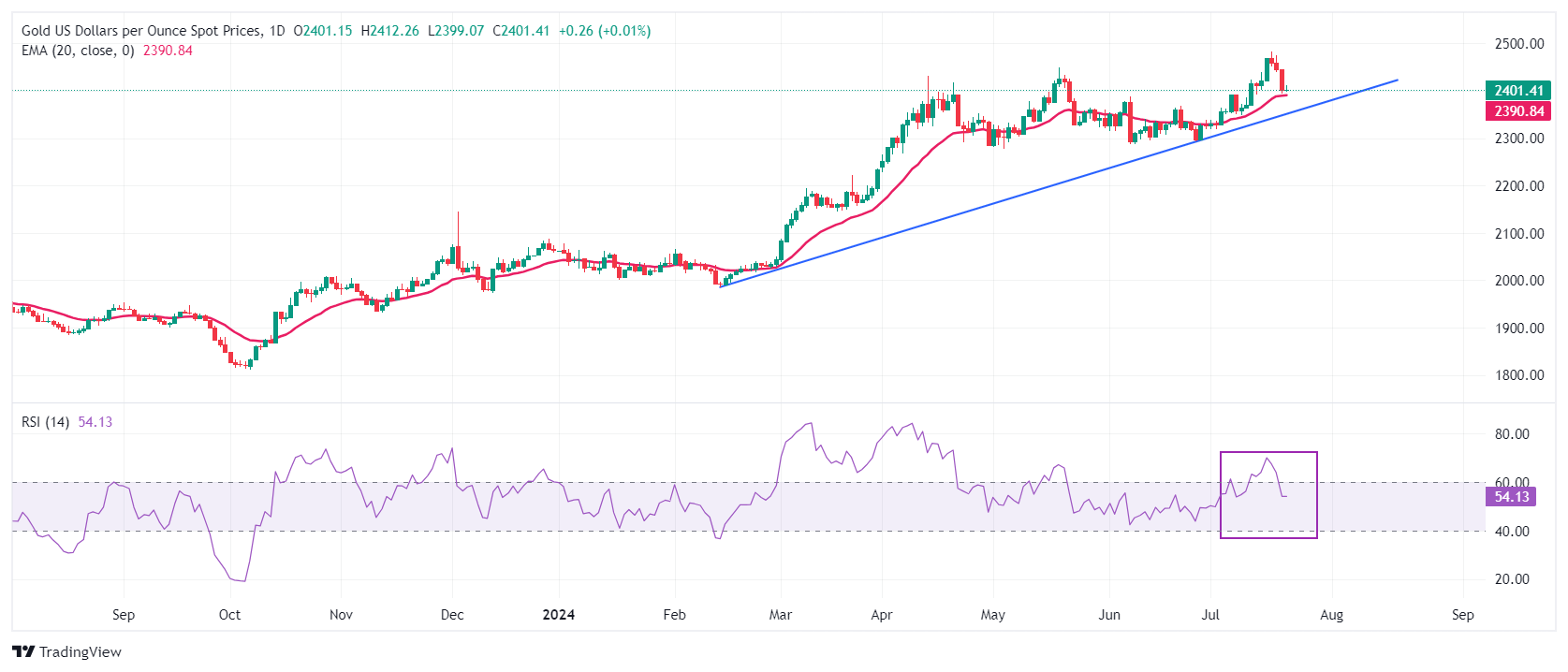- Gold price slips despite uncertainty over US presidential elections.
- US President Biden withdraws the re-election bid and nominates Kamala Harris to lead the Democrats.
- The US Dollar edges lower ahead of US data-packed week
Gold price (XAU/USD) edges lower slightly below the key support of $2,400 in Monday’s New York session. The precious slips despite the nomination of Vice President Kamala Harris to lead Democrats against Donald Trump-led-Republicans deepenes United States (US) political uncertainty. The withdrawal of US President Joe Biden from the re-election bid paved the way for Kamala Harris as the nominee of Democrats. Historically, investors channelize investments toward Gold as a hedge against political uncertainty.
This has also stalled upside in the US Dollar (USD). The US Dollar Index (DXY), which tracks the Greenback’s value against six major currencies, slightly retraces to 104.20 on Monday after a strong recovery from a four-month low of 103.65. Earlier, higher odds of Trump’s win in presidential elections fueled a recovery in the US Dollar. Market experts saw Trump’s victory as favorable for economic growth as he has promised cuts in corporate taxes and interest rates. This has fuelled upside risks to consumer inflation expectations. Experts also expect further trade restrictions if Republicans enter the White House. The prospects of Donald Trump winning elections grew after an assassination attack on him.
Meanwhile,10-year US Treasury yields decline to 4.22%. Lower yields on interest-bearing assets reduce the opportunity cost of investing in non-yielding assets, such as Gold.
Daily digest market movers: Gold price dips, US Dollar, bond yields edge lower
- Gold price skids below the key support of $2,400 after declining consecutively for three trading days, with the focus on US data-packed week. The economic data will provide fresh cues about when the Federal Reserve (Fed) will start reducing interest rates this year.
- This week, investors will focus on the preliminary S&P Global Purchasing Managers Index (PMI) for July, Q2 Gross Domestic Product (GDP), and the Durable Goods Orders and Personal Consumption Expenditure Price Index (PCE) for June. According to the estimates, advanced PMI expanded at a slower pace than the previous month. Meanwhile, the GDP is expected to expand at a strong pace of 2.0% on an annualized basis from the former release of 1.4%.
- Investors will keenly focus on the core PCE inflation data, which is the Fed’s preferred inflation gauge. On a monthly basis, the inflation measure is estimated to have grown at a faster pace of 0.2% from the former reading of 0.1%.
- Currently, financial markets expect the Fed to begin lowering its key borrowing rates in September and deliver two rate cuts this year against one projected by policymakers in the latest dot plot.
- Recently, the confidence of Fed officials that inflation has returned on its path to 2% has increased. June’s inflation readings showed that price pressures grew at a slower-than-expected pace. Also, monthly headline inflation deflated for the first time in more than four years.
Technical Analysis: Gold price struggles to hold ground above $2,400
Gold price trades in a tight range near $2,400 on Monday. The precious metal declines to near the 20-day Exponential Moving Average (EMA), which trades around $2,390, and suggests that the near-term outlook has not weakened yet technically.
Advancing trendline plotted from the February 14 low at $1,984.30 will be a major support for Gold bulls.
The 14-day Relative Strength Index (RSI) drops inside the 40.00-60.00 range, suggesting that the upside momentum has stalled. However, the upside bias remains intact.
A fresh upside would appear if the Gold price breaks above the all-time-high around $2,480.
Fed FAQs
Monetary policy in the US is shaped by the Federal Reserve (Fed). The Fed has two mandates: to achieve price stability and foster full employment. Its primary tool to achieve these goals is by adjusting interest rates. When prices are rising too quickly and inflation is above the Fed’s 2% target, it raises interest rates, increasing borrowing costs throughout the economy. This results in a stronger US Dollar (USD) as it makes the US a more attractive place for international investors to park their money. When inflation falls below 2% or the Unemployment Rate is too high, the Fed may lower interest rates to encourage borrowing, which weighs on the Greenback.
The Federal Reserve (Fed) holds eight policy meetings a year, where the Federal Open Market Committee (FOMC) assesses economic conditions and makes monetary policy decisions. The FOMC is attended by twelve Fed officials – the seven members of the Board of Governors, the president of the Federal Reserve Bank of New York, and four of the remaining eleven regional Reserve Bank presidents, who serve one-year terms on a rotating basis.
In extreme situations, the Federal Reserve may resort to a policy named Quantitative Easing (QE). QE is the process by which the Fed substantially increases the flow of credit in a stuck financial system. It is a non-standard policy measure used during crises or when inflation is extremely low. It was the Fed’s weapon of choice during the Great Financial Crisis in 2008. It involves the Fed printing more Dollars and using them to buy high grade bonds from financial institutions. QE usually weakens the US Dollar.
Quantitative tightening (QT) is the reverse process of QE, whereby the Federal Reserve stops buying bonds from financial institutions and does not reinvest the principal from the bonds it holds maturing, to purchase new bonds. It is usually positive for the value of the US Dollar.

